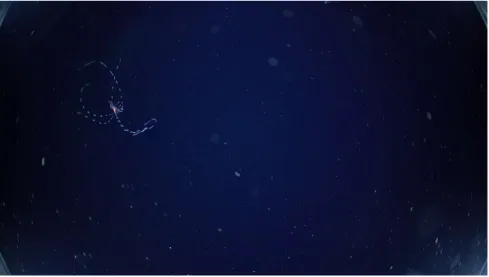Weekly report cruise POS532 By Henk-Jan Hoving
11/2/2019-17/2/2019 (written on 17/2/2019)
One of the large instrumentation that we brought on board is the Werner winch, a 10 tons heavy winch that has 4000 m of fibre optic cable on its drum. On POSEIDON, this fibre optic cable is paid out via a central block on the A-frame on the back of the ship. The Werner winch is used to tow the newly developed pelagic in situ observation system: PELAGIOS II. Technicians of GEOMAR’s TLZ have been working during the last year to develop this system, which consists of a GEOMAR in-house developed fibre optic telemetry, which streams a high quality live preview of the underwater imagery to the ship. It also enables streaming of additional sensor data and currently is equipped with a CTD. The PELAGIOS II fibre optic system can be deployed down to 6000 m, and for this cruise is equipped with a 4K camera with fish-eye lens, also developed at GEOMAR. On 11/2 we deployed the PELAGIOS II system for the first time in the field. The new square frame is practical, both for attachment and adjustment of instruments, as well as for safe deployment and recovery, and proved to be very stable and balanced during tows.
The live streaming of high quality video is a great improvement for pelagic video transects and enables scientists to make notes and pre-processing of obtained observations already during the survey, which increases efficiency of the video analysis. Also, it allows for targeted observations of thin layers with aggregations of certain species. After some initial test deployments to adjust camera settings and lighting, we performed a full day and night pelagic video transect from 50 to 1000 m off the coast of Fogo on 15/2. The gelatinous fauna that we know from this region were visible, and observed organisms include ctenophores, medusa and siphonophores.
Figure 1: Frame grab of a pelagic crustacean encountered during a pelagic video transect at 900 m by PELAGIOS II
To increase flexibility in the cruise program, the crew of POSEIDON prepared on 10/2 a second block on the A-frame that allows for the use of the W6 winch. This winch has a conducting wire and on this cruise we deploy and tow the Multinet maxi during day and night deployments to allow quantification of the daily vertical migration of zooplankton and micronekton. The samples of the multinet are preserved in
formalin for analysis in the lab after the cruise but before fixing, we look through the samples to select specimens for scientific photography to document colour and other characters that are lost after preservation.
Figure 2: A pteropod mollusk and ctenophore captured by multinet and photographed in the lab on board POSEIDON (photograph by K. Osborn)
In the evening of 12/2, after a day of JAGO dives we left the Bay of Tarrafal, an ideal place for deep-sea biological research. During the night, we transited to the time series station Cape Verde Ocean
Observatory (17°35’N - 024°17’W). We started doing CTDs for hydrography at 04:00 am on 13/2. We collected samples for dissolved inorganic carbon measurements for our colleagues of marine
biogeochemistry. Biological samples were collected using the multinet midi over the W2 winch, and we performed two deep CTDs for the collection of environmental DNA which will be analyzed for
bathypelagic biodiversity. At the end of our CVOO station work we looked for the CVOO mooring, following a request from colleagues on shore since the top buoy has stopped communication. The last position of this mooring was noted in August 2018. We searched with the officers and captain on the bridge of POSEIDON using binoculars, scanning the wide ocean, and by steaming in between the positions where it was last observed. We were about to give up when the captain suggested to make one more maneuver, and then the mooring buoy was spotted. 20 minutes later the mooring buoy was photographed at the surface, the exact position was noted and was communicated to our colleagues of physical oceanography. We then proceeded our transit to Fogo.
In the morning of 14/2 we started diving with JAGO off Fogo, and performed another dive in the evening. Then two days of intensive W2 and W6 sampling followed, with a CTD transect perpendicular to the islands’ slope along with hydroacoustic observations as well as deployments of the multinet and
PELAGIOS. Unfortunately, currents and wind are more difficult off Fogo and we had to cancel an OFOS survey, a multinet maxi deployment and a PELAGIOS survey due to unfavourable sea conditions. In the night of 15/2, while we performed an ADCP transect to approximately twelve nautical offshore, the high swell and strong winds that we encountered gave us a reality check of the rough ocean that exists outside the sheltered conditions that we experience in the leeway of the islands.
Figure 3: POSEIDON off Fogo and JAGO being recovered after a dive.
Today on 17/2 we are doing a JAGO day and we started in the morning with a pelagic dive (JAGO dive no. 13 of POS532) over 800 m of depth. I dove in the submersible with Peter Striewski as the pilot. It was a spectacular dive with incredible observations of large pelagic fauna such as the siphonophore
Apolemia, which measured several meters. We collected specimens of the ctenophore Beroe, which is a predator that feeds on other gelatinous fauna. Biological associations between fauna were observed for fishes and the ctenophore Leucothea. A variety of delicate pelagic animals were encountered and closely observed and recorded and we stayed in the upper 200 m of the water column.
Figure 4: In situ observations of the large siphonophore Apolemia obtained by JAGO


